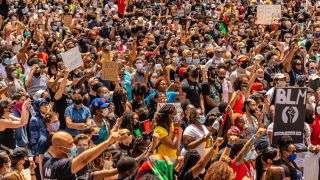
Large crowds protest police brutality and the killing of George Floyd by police. The Black Lives Matter protest, seen here on June 19, 2020, in downtown Chicago, is just one of thousands across the U.S. and globe.
In 2012, University of Connecticut ecologist, evolutionary biologist and mathematician Peter Turchin made a bold prediction: The United States was on track for a chaotic, violent 2020.
Well, here we are.
The year so far has been full of “upheaval” events, from a pandemic that seems to be further polarizing Americans along party lines, to the police killing of George Floyd and other Black individuals, which have led to Black Lives Matter protests worldwide and riots in some cities.
Turchin wasn’t just spitballing when he foresaw trouble in the 2020s. In his 2012 article, published in the Journal of Peace Research, he analyzed political violence, including riots, lynchings and terrorism, in the United States between 1780 and 2010. He found two patterns: First, a long trend of peace followed by rising violence that seems to span about 200 or 300 years, marked in this case by relative peace in the early 1800s, major upheaval in the mid- to late-1800s, and then peace again in the mid-1900s. Superimposed upon this long-term curve were oscillations that seemed to repeat approximately every 50 years. Violence peaked around 1870, 1920 and 1970. Extrapolate another 50 years and you land right smack on 2020.
Cycles of violence?
Turchin theorizes that it’s no coincidence that upheaval comes in 50-year cycles. In fact, he argues that these cycles appear again and again in different countries throughout history. Social problems such as economic inequality lead to increasing civil unrest over time, he said, creating a violent peak. Chastened and traumatized, society turns its attention toward quelling the violence no matter what, and relative peace returns for 20 or 30 years, about the length of an adult generation. At that point, the underlying problems will likely bubble up again, and the new generation won’t be so dedicated to peace and tranquility.
Since his paper was published, there has been debate over whether the 50-year rule really holds, and what the possible reasons for cycles of violence might be. In 2012, City University of New York, Lehman College philosopher of science Massimo Pigliucci told Live Science that 230 years of U.S. history isn’t enough to draw firm conclusions about the cyclicity of upheaval and violence. And indeed, there were no major upheavals in 1820, 50 years before the fury of the U.S. Civil War and Reconstruction. Ilona M. Otto, a sociologist and economist at the Potsdam Institute for Climate Impact research thinks that violence rises and falls because after a period of upheaval, people create institutions to deal with their current problems. The institutions work — for a while.
“After some time, new challenges come up and those institutions are no longer suitable to deal with these new problems,” Otto told Live Science. If the institutions aren’t flexible enough to change, the result can be revolution or war.
Regardless of the debate over timing, Turchin said that the social conditions now are ripe for a tumultuous decade.
“The prediction [of violence] followed from observing the trends that make a violent upheaval increasingly likely — falling living standards for the majority of population, growing intra-elite competition and conflict,” Turchin wrote in an email to Live Science. Intra-elite competition is the battle for wealth and resources among the already well-off or politically connected. “These trends didn’t go away and continue developing in unfavorable directions. This means that there will be more turbulence, driven by other immediate triggers.”
Related Content
—Fight, fight, fight: The history of human aggression
—Understanding the 10 most destructive human behaviors
—Infographic: Cycles of violence in the US
The turbulent Twenties
History may look back upon the 2020s as the “turbulent twenties,” said Jack Goldstone, a sociologist at George Mason University in Virginia, whose work provides the foundation of much of Turchin’s research.
“The pandemic and police brutality this year acted as ‘triggers’ to unleash the pressures for violence that had been rising for some time,” Goldstone told Live Science in an email. “What the model predicts is that the 2020s will be dangerous, and that unless the underlying pressures are reduced, the late 2020s and 2030s could be even worse.”
Otto agreed that issues of wealth inequality and unequal access to education and health care resources are straining U.S. society. Whether the current simmer boils over into a violent decade depends on people’s willingness to restructure policies and institutions to solve these problems, she said.
Cycles of violence aren’t driven by fate, Goldstone said, but by society’s responses to challenges. “For the last 40 years, the U.S. has been in a cycle of rising inequality, greater political polarization, rising government debts and government dysfunction,” Goldstone said. “If we arrest those trends, we can change the cycle by reform. If we don’t arrest those trends, the cycle will take us into crisis.”
The election of November 2020 may be a test. If Democrats sweep Congress and take the presidency, there may be a chance for major reforms within the political process, Goldstone said, but reforms will not come easily. Another possibility is that the election is a narrow victory one way or another, leading to a contested election and probably further street protests.
“Either way,” Goldstone said, “November 2020 will be a major struggle in which we cannot trust that our normal institutions will hold.”
Sourse: www.livescience.com





